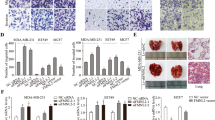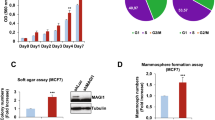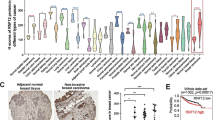Abstract
Myosin light chain kinase (MLCK) expression is downregulated in breast cancer, including invasive ductal carcinoma compared with ductal breast carcinoma in situ and metastatic breast tumors. However, little is known about how loss of MLCK expression contributes to tumor progression. MLCK is a component of the actin cytoskeleton and its known role is the phosphorylation of the regulatory light chain of myosin II. To gain insights into the role of MLCK in breast cancer, we perturbed its function using small interfering RNA (siRNA) or pharmacological inhibition in untransformed breast epithelial cells (MCF10A). Loss of MLCK by siRNAs led to increased cell migration and invasion, disruption of cell–cell adhesions and enhanced formation of focal adhesions at the leading edge of migratory cells. In addition, downregulation of MLCK cooperated with HER2 in MCF10A cells to promote cell migration and invasion and low levels of MLCK is associated with a poor prognosis in HER2-positive breast cancer patients. Associated with these altered migratory behaviors were increased expression of epidermal growth factor receptor and activation of extracellular signal-regulated kinase and c-Jun N-terminal kinase signaling pathways in MLCK downregulated MCF10A cells. By contrast, inhibition of the kinase function of MLCK using pharmacological agents inhibited cell migration and invasion, and did not affect cellular adhesions. Our results show that loss of MLCK contributes to the migratory properties of epithelial cells resulting from changes in cell–cell and cell–matrix adhesions, and increased epidermal growth factor receptor signaling. These findings suggest that decreased expression of MLCK may have a critical role during tumor progression by facilitating the metastatic potential of tumor cells.
This is a preview of subscription content, access via your institution
Access options
Subscribe to this journal
Receive 50 print issues and online access
$259.00 per year
only $5.18 per issue
Buy this article
- Purchase on Springer Link
- Instant access to full article PDF
Prices may be subject to local taxes which are calculated during checkout









Similar content being viewed by others
References
Yilmaz M, Christofori G . EMT, the cytoskeleton, and cancer cell invasion. Cancer Metastasis Rev 2009; 28: 15–33.
Rhodes DR, Kalyana-Sundaram S, Mahavisno V, Varambally R, Yu J, Briggs BB et al. Oncomine 3.0: genes, pathways, and networks in a collection of 18,000 cancer gene expression profiles. Neoplasia (New York, NY) 2007; 9: 166.
Yu HJ, Serebryannyy LA, Fry M, Greene M, Chernaya O, Hu WY et al. Tumor stiffness is unrelated to myosin light chain phosphorylation in cancer cells. PloS One 2013; 8: e79776.
Wu Q, Sahasrabudhe RM, Luo LZ, Lewis DW, Gollin SM, Saunders WS . Deficiency in myosin light-chain phosphorylation causes cytokinesis failure and multipolarity in cancer cells. Oncogene 2010; 29: 4183–4193.
Curtis C, Shah SP, Chin SF, Turashvili G, Rueda OM, Dunning MJ et al. The genomic and transcriptomic architecture of 2,000 breast tumours reveals novel subgroups. Nature 2012; 486: 346–352.
Zhao H, Langerod A, Ji Y, Nowels KW, Nesland JM, Tibshirani R et al. Different gene expression patterns in invasive lobular and ductal carcinomas of the breast. Mol Biol Cell 2004; 15: 2523–2536.
Choi C, Helfman DM . The Ras-ERK pathway modulates cytoskeleton organization, cell motility and lung metastasis signature genes in MDA-MB-231 LM2. Oncogene 2014; 33: 3668–3676.
Watterson DM, Collinge M, Lukas TJ, Van Eldik LJ, Birukov KG, Stepanova OV et al. Multiple gene products are produced from a novel protein kinase transcription region. FEBS Lett 1995; 373: 217–220.
Verin AD, Gilbert-McClain LI, Patterson CE, Garcia JG . Biochemical regulation of the nonmuscle myosin light chain kinase isoform in bovine endothelium. Am J Respir Cell Mol Biol 1998; 19: 767–776.
Wadgaonkar R, Nurmukhambetova S, Zaiman AL, Garcia JG . Mutation analysis of the non-muscle myosin light chain kinase (MLCK) deletion constructs on CV1 fibroblast contractile activity and proliferation. J Cell Biochem 2003; 88: 623–634.
Fazal F, Gu L, Ihnatovych I, Han Y, Hu W, Antic N et al. Inhibiting myosin light chain kinase induces apoptosis in vitro and in vivo. Mol Cell Biol 2005; 25: 6259–6266.
Connell LE, Helfman DM . Myosin light chain kinase plays a role in the regulation of epithelial cell survival. J Cell Sci 2006; 119: 2269–2281.
Gu LZ, Hu WY, Antic N, Mehta R, Turner JR, de Lanerolle P . Inhibiting myosin light chain kinase retards the growth of mammary and prostate cancer cells. Eur J Cancer 2006; 42: 948–957.
Wang HH, Nakamura A, Matsumoto A, Yoshiyama S, Qin X, Ye LH et al. Nonkinase activity of MLCK in elongated filopodia formation and chemotaxis of vascular smooth muscle cells toward sphingosylphosphorylcholine. Am J Physiol Heart Circ Physiol 2009; 296: H1683–H1693.
Dudek SM, Chiang ET, Camp SM, Guo Y, Zhao J, Brown ME et al. Abl tyrosine kinase phosphorylates nonmuscle Myosin light chain kinase to regulate endothelial barrier function. Mol Biol Cell 2010; 21: 4042–4056.
Usatyuk PV, Singleton PA, Pendyala S, Kalari SK, He D, Gorshkova IA et al. Novel role for non-muscle myosin light chain kinase (MLCK) in hyperoxia-induced recruitment of cytoskeletal proteins, NADPH oxidase activation, and reactive oxygen species generation in lung endothelium. J Biol Chem 2012; 287: 9360–9375.
Simpson KJ, Selfors LM, Bui J, Reynolds A, Leake D, Khvorova A et al. Identification of genes that regulate epithelial cell migration using an siRNA screening approach. Nat Cell Biol 2008; 10: 1027–1038.
Chen C, Tao T, Wen C, He WQ, Qiao YN, Gao YQ et al. Myosin light chain kinase (MLCK) regulates cell migration in a myosin regulatory light chain phosphorylation-independent mechanism. J Biol Chem 2014; 289: 28478–28488.
Webb DJ, Donais K, Whitmore LA, Thomas SM, Turner CE, Parsons JT et al. FAK-Src signalling through paxillin, ERK and MLCK regulates adhesion disassembly. Nat Cell Biol 2004; 6: 154–161.
Ridley AJ, Schwartz MA, Burridge K, Firtel RA, Ginsberg MH, Borisy G et al. Cell migration: integrating signals from front to back. Science 2003; 302: 1704–1709.
Yilmaz M, Christofori G . Mechanisms of motility in metastasizing cells. Mol Cancer Res 2010; 8: 629–642.
Kalluri R, Weinberg RA . The basics of epithelial-mesenchymal transition. J Clin Invest 2009; 119: 1420–1428.
Lin RZ, Chou LF, Chien CC, Chang HY . Dynamic analysis of hepatoma spheroid formation: roles of E-cadherin and beta1-integrin. Cell Tissue Res 2006; 324: 411–422.
Ivascu A, Kubbies M . Diversity of cell-mediated adhesions in breast cancer spheroids. Int J Oncol 2007; 31: 1403–1413.
Sodek KL, Ringuette MJ, Brown TJ . Compact spheroid formation by ovarian cancer cells is associated with contractile behavior and an invasive phenotype. Int J Cancer 2009; 124: 2060–2070.
Glinsky VV, Glinsky GV, Glinskii OV, Huxley VH, Turk JR, Mossine VV et al. Intravascular metastatic cancer cell homotypic aggregation at the sites of primary attachment to the endothelium. Cancer Res 2003; 63: 3805–3811.
Huang C, Jacobson K, Schaller MD . A role for JNK-paxillin signaling in cell migration. Cell Cycle 2004; 3: 4–6.
Huang C, Rajfur Z, Borchers C, Schaller MD, Jacobson K . JNK phosphorylates paxillin and regulates cell migration. Nature 2003; 424: 219–223.
Kimura K, Teranishi S, Yamauchi J, Nishida T . Role of JNK-dependent serine phosphorylation of paxillin in migration of corneal epithelial cells during wound closure. Invest Ophthalmol Vis Sci 2008; 49: 125–132.
Chen J, Gallo KA . MLK3 regulates paxillin phosphorylation in chemokine-mediated breast cancer cell migration and invasion to drive metastasis. Cancer Res 2012; 72: 4130–4140.
Duan L, Raja SM, Chen G, Virmani S, Williams SH, Clubb RJ et al. Negative regulation of EGFR-Vav2 signaling axis by Cbl ubiquitin ligase controls EGF receptor-mediated epithelial cell adherens junction dynamics and cell migration. J Biol Chem 2011; 286: 620–633.
Gyorffy B, Lanczky A, Eklund AC, Denkert C, Budczies J, Li Q et al. An online survival analysis tool to rapidly assess the effect of 22,277 genes on breast cancer prognosis using microarray data of 1,809 patients. Breast Cancer Res Treat 2010; 123: 725–731.
Olson MF, Sahai E . The actin cytoskeleton in cancer cell motility. Clin Exp Metastasis 2009; 26: 273–287.
Garcia JG, Verin AD, Schaphorst K, Siddiqui R, Patterson CE, Csortos C et al. Regulation of endothelial cell myosin light chain kinase by Rho, cortactin, and p60(src). Am J Physiol 1999; 276: L989–L998.
Totsukawa G, Yamakita Y, Yamashiro S, Hartshorne DJ, Sasaki Y, Matsumura F . Distinct roles of ROCK (Rho-kinase) and MLCK in spatial regulation of MLC phosphorylation for assembly of stress fibers and focal adhesions in 3T3 fibroblasts. J Cell Biol 2000; 150: 797–806.
Totsukawa G, Wu Y, Sasaki Y, Hartshorne DJ, Yamakita Y, Yamashiro S et al. Distinct roles of MLCK and ROCK in the regulation of membrane protrusions and focal adhesion dynamics during cell migration of fibroblasts. J Cell Biol 2004; 164: 427–439.
Birukov KG, Csortos C, Marzilli L, Dudek S, Ma SF, Bresnick AR et al. Differential regulation of alternatively spliced endothelial cell myosin light chain kinase isoforms by p60(Src). J Biol Chem 2001; 276: 8567–8573.
Dudek SM, Birukov KG, Zhan X, Garcia JG . Novel interaction of cortactin with endothelial cell myosin light chain kinase. Biochem Biophys Res Commun 2002; 298: 511–519.
Ren G, Helwani FM, Verma S, McLachlan RW, Weed SA, Yap AS . Cortactin is a functional target of E-cadherin-activated Src family kinases in MCF7 epithelial monolayers. J Biol Chem 2009; 284: 18913–18922.
Mukherjee M, Chow SY, Yusoff P, Seetharaman J, Ng C, Sinniah S et al. Structure of a novel phosphotyrosine-binding domain in Hakai that targets E-cadherin. EMBO J 2012; 31: 1308–1319.
Hazan RB, Norton L . The epidermal growth factor receptor modulates the interaction of E-cadherin with the actin cytoskeleton. J Biol Chem 1998; 273: 9078–9084.
Bill HM, Knudsen B, Moores SL, Muthuswamy SK, Rao VR, Brugge JS et al. Epidermal growth factor receptor-dependent regulation of integrin-mediated signaling and cell cycle entry in epithelial cells. Mol Cell Biol 2004; 24: 8586–8599.
Streuli CH, Akhtar N . Signal co-operation between integrins and other receptor systems. Biochem J 2009; 418: 491–506.
Cabodi S, Moro L, Bergatto E, Boeri Erba E, Di Stefano P, Turco E et al. Integrin regulation of epidermal growth factor (EGF) receptor and of EGF-dependent responses. Biochem Soc Trans 2004; 32: 438–442.
Laprise P, Langlois MJ, Boucher MJ, Jobin C, Rivard N . Down-regulation of MEK/ERK signaling by E-cadherin-dependent PI3K/Akt pathway in differentiating intestinal epithelial cells. J Cell Physiol 2004; 199: 32–39.
Li Q, Mattingly RR . Restoration of E-cadherin cell-cell junctions requires both expression of E-cadherin and suppression of ERK MAP kinase activation in Ras-transformed breast epithelial cells. Neoplasia 2008; 10: 1444–1458.
Giampieri S, Manning C, Hooper S, Jones L, Hill CS, Sahai E . Localized and reversible TGFbeta signalling switches breast cancer cells from cohesive to single cell motility. Nat Cell Biol 2009; 11: 1287–1296.
Dulyaninova NG, Patskovsky YV, Bresnick AR . The N-terminus of the long MLCK induces a disruption in normal spindle morphology and metaphase arrest. J Cell Sci 2004; 117: 1481–1493.
Hidalgo-Carcedo C, Hooper S, Chaudhry SI, Williamson P, Harrington K, Leitinger B et al. Collective cell migration requires suppression of actomyosin at cell-cell contacts mediated by DDR1 and the cell polarity regulators Par3 and Par6. Nat Cell Biol 2011; 13: 49–58.
Acknowledgements
DMH is supported by the National Research Foundation of Korea funded by the Ministry of Education Science and Technology (#R1A2A2A01003372).
Author information
Authors and Affiliations
Corresponding author
Ethics declarations
Competing interests
The authors declare no conflict of interest.
Additional information
Supplementary Information accompanies this paper on the Oncogene website
Supplementary information
Rights and permissions
About this article
Cite this article
Kim, D., Helfman, D. Loss of MLCK leads to disruption of cell–cell adhesion and invasive behavior of breast epithelial cells via increased expression of EGFR and ERK/JNK signaling. Oncogene 35, 4495–4508 (2016). https://doi.org/10.1038/onc.2015.508
Received:
Revised:
Accepted:
Published:
Issue Date:
DOI: https://doi.org/10.1038/onc.2015.508
This article is cited by
-
IGF2BP3-mediated enhanced stability of MYLK represses MSC adipogenesis and alleviates obesity and insulin resistance in HFD mice
Cellular and Molecular Life Sciences (2024)
-
GPR65 inhibits human trophoblast cell adhesion through upregulation of MYLK and downregulation of fibronectin via cAMP-ERK signaling in a low pH environment
Cell Communication and Signaling (2023)
-
Identification of epigenetic modifications mediating the antagonistic effect of selenium against cadmium-induced breast carcinogenesis
Environmental Science and Pollution Research (2022)
-
Sec62 promotes early recurrence of hepatocellular carcinoma through activating integrinα/CAV1 signalling
Oncogenesis (2019)
-
MYLK promotes hepatocellular carcinoma progression through regulating cytoskeleton to enhance epithelial–mesenchymal transition
Clinical and Experimental Medicine (2018)



